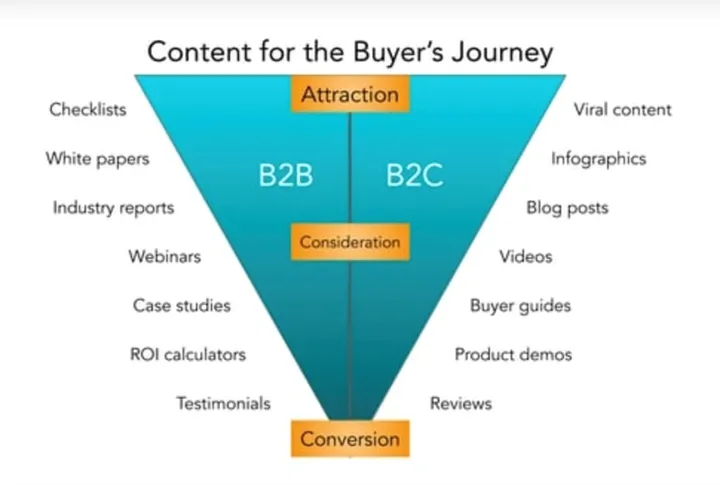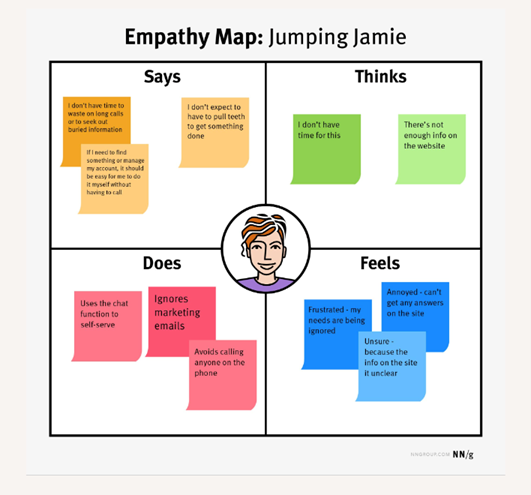Content is everywhere. From the moment we wake up to the time we drift off to sleep, we're bombarded with a relentless barrage of messages vying for our attention. Whether it's the catchy jingle on the radio, the sponsored post in our social media feed, or a huge billboard looming over us from above, we're surrounded by communication.
But have you ever stopped to wonder where all this content comes from? Behind every clever tagline, captivating video, or insightful blog post lies a hidden world of decision-makers, creatives, and countless hours of brainstorming, strategizing, and execution.
97% of marketers use content marketing as part of their marketing strategy, but with thousands of B2B brands out there battling for our attention, how do they actually get it?
This is where B2B content marketing plans come into play. And it’s time to find out how you can do it too.
What is B2B Content Marketing?
B2B content marketing is about strategically crafting and sharing valuable, relevant, and consistent content to catch the attention of a specific audience. Unlike traditional advertising, which focuses on directly promoting products or services, B2B content marketing aims to provide informative and educational content that addresses the pain points, challenges, and interests of businesses within a particular industry or niche.
At its core, B2B content marketing is about building trust, establishing thought leadership, and nurturing long-term relationships with potential clients or customers. In the B2B landscape, purchasing decisions are often complex, involving multiple stakeholders and a lengthy decision-making process, but by delivering high-quality content that helps businesses solve problems or make informed decisions, companies can position themselves as valuable partners rather than just vendors.
Why is content marketing important for B2B businesses?
Content marketing is a crucial element to any marketing plan, allowing you to establish credibility and gain audience trust. And while 40% of B2B marketers have a documented content marketing strategy, 27% have none whatsoever. Building a sturdy content marketing plan can have a huge impact on your business, for example, it can:
1. Simplify the customer acquisition process
A well-executed content marketing plan can streamline the customer acquisition process by providing valuable information to potential customers at every stage of their buyer's journey – as highlighted in the above framework. By offering educational content that addresses their pain points and challenges, your company will attract prospects and guide them through the decision-making process. From awareness to consideration and finally to conversion, content marketing can serve as a guiding light, nurturing leads and making it easier for them to choose your products or services.
2. Support your business growth with long-lasting content
Content marketing plays a pivotal role in supporting business growth by driving traffic, generating leads, and increasing conversions. By consistently producing high-quality content that lasts a long time and resonates with your target audience, you can expand your reach, attract new customers, and retain existing ones. It can also help to differentiate your brand from competitors, establish thought leadership, and position your business as a trusted authority in your industry, paving the way for sustainable growth and success.
3. Help to build your brand
Building a strong brand narrative is essential for standing out in today's competitive marketplace, and content marketing can be a powerful tool in achieving this goal. Through compelling storytelling, consistent messaging, and engaging content experiences, a company can shape perceptions, evoke emotions, and foster meaningful connections with their audience. By showcasing your unique value proposition, demonstrating expertise, and aligning with your audience's values, B2B content marketing will help to build brand awareness, credibility, and loyalty over time.
4. Enable audience feedback
One of the often-overlooked benefits of content marketing is its ability to facilitate two-way communication and enable audience feedback. By encouraging comments, shares, and discussions around your content, businesses can gain valuable insights into their audience's preferences, opinions, and needs. This feedback can then be used to refine your content strategy, tailor your messaging, and improve the overall customer experience. Content marketing platforms often provide analytics and metrics that allow B2B businesses to track engagement, measure performance, and continuously update and improve their content strategy.
A huge 81% of buyers in B2B marketing feel that they could make more informed decisions if B2B advertising strategies were more effective at capturing their attention and interest, so keep this in mind when developing your own strategy.
B2B Content Marketing vs. B2C Content Marketing
As with most things in marketing, there are always nuances. What might work in the B2C world won’t necessarily work for B2B. Understanding the difference between the two, including the different audiences, their purchasing behaviors and the platforms they engage with, is crucial for crafting effective marketing messages and choosing the right channels to reach them.
B2B Content Marketing
When it comes to B2B, the audience typically comprises professionals, decision-makers, and stakeholders within other businesses. These individuals are often driven by logic, ROI (Return on Investment), and the need to solve specific business challenges. As a result, B2B content tends to focus on providing in-depth industry insights, thought leadership content, case studies, and product demonstrations that address the practical needs and pain points of businesses.
B2C Content Marketing
In comparison, B2C content marketing targets individual consumers who make purchasing decisions based on emotion, lifestyle preferences, and personal desires. They’re often more receptive to entertaining, visually appealing, and emotionally resonant content that speaks directly to their aspirations and desires. B2C content will usually include lifestyle blogs, influencer collaborations, user-generated content, and visually engaging social media posts. Platforms such as Instagram, X, Facebook, YouTube, and TikTok are popular among B2C brands for reaching and engaging with their target audience, as these platforms tend to allow for more creative storytelling and visual content that can capture consumer attention and help to drive more engagement.
Content Strategy Similarities
Despite the traditionally distinct approaches to B2B and B2C content marketing, we are starting to see a convergence of marketing trends. B2B audiences are increasingly seeking out storytelling and emotionally resonant content in their marketing messages, recognizing the power of narrative to engage and inspire action. Similarly, B2C brands are incorporating more informative and educational content into their marketing strategies to build trust and credibility with consumers.
The rise of video content marketing has played a significant role in blurring the lines between B2B and B2C marketing, with both audiences being drawn to the engaging and immersive nature of video, whether it's in the form of product demos, customer testimonials, or behind-the-scenes footage. As a result, video has become an integral part of content strategies for both B2B and B2C brands, offering a versatile and impactful medium to connect with audiences and drive meaningful engagement.
8 Steps for Creating your B2B Content Marketing Strategy
1. Define the goal of your content strategy
Adapt your content strategy to your company's growth stage, experimenting with short, lifecycle content in the early stage, and transition to building long-term content programs in the growth stage. Ensure your content aligns with the overarching goals of easing customer acquisition, supporting business growth, building brand identity, and gathering audience feedback.
2. Understand your audience
Carry out thorough research to identify your target audience, their needs, pain points, preferences, and behaviors, using these to develop detailed buyer personas to guide your content creation efforts and ensure your content resonates with your audience.
Some of the questions you might want to ask could be:
- What are their demographics?
- What are their goals?
- What are their barriers to purchase?
- How can you help overcome these?
3. Conduct a competitive analysis
When brainstorming for your B2B content marketing strategy, it’s important to conduct a competitive analysis to find out what you should include in your campaigns. You should be focusing on what your competitors are doing that you are not, and whether or not it is working for them. This will give you a clear idea of what to include in and remove from your campaign to create one that stands out from the rest!
4. Establish clear messaging and positioning
Define your brand's unique value proposition, key messaging points, and positioning in the market. When doing this, make sure you have consistency in your tone, voice, and messaging across all content channels to reinforce your brand identity and enhance brand recognition. An Empathy Map is a great way for marketers to do this, helping them really understand the thoughts and feelings of different groups on specific issues, tailoring your content to suit their needs. Here’s a great example from Nielsen Norman Group.
5. Choose the right content formats and channels
Select content formats and distribution channels that align with your audience's preferences and behaviors. Consider using a mix of written content, visual content, video content, podcasts, webinars, and social media platforms to reach and engage your target customers effectively.
Tailoring your content to specific channels can enhance its performance significantly. For instance, concise and visually appealing content tends to perform well on social media platforms like Instagram and Twitter. In contrast, longer-form content such as explainer videos, blog posts or articles might be better suited for email newsletters or LinkedIn.
Video content often garners higher engagement rates on platforms like YouTube and Facebook, while podcasts and webinars cater to audiences seeking in-depth discussions or educational content. By understanding your audience and their preferred platforms, you can optimize your social media content creation strategy to maximize engagement and achieve your marketing goals.
6. Develop a content calendar and plan
Create a content calendar outlining the topics, themes, and publishing schedule for your content, ensuring your content plan aligns with your overall marketing objectives and addresses the various stages of the buyer's journey, from awareness to consideration and decision-making.
If you want to get a head start on building your own content calendar, you can download one for free from HubSpot! (And you can also get a list of the most important events for your calendar on our website.)
7. Measure and analyze performance
Implement tracking mechanisms to monitor the performance of your content marketing efforts and use these to measure essential key metrics for marketers such as website traffic, engagement rates, lead generation, conversion rates, and ROI. Use analytics data to identify areas for improvement and optimize your content strategy over time.
Some of the metrics you might want to look out for include:
Website traffic
If you’re directing people to your website from your content, make sure to keep an eye on how many visitors you’re getting over time to see if it’s driving traffic. Very interesting data for your SEO.
Engagement rates
Take a look at the engagement that you get on your socials and website (i.e. click-through-rates, bounce rates, likes, follows etc.) as this is a great indicator of how well your content is connecting with your audience.
Lead generation
Track the number of leads generated through your content, whether it's through gated content downloads, newsletter sign-ups, or other conversion points.
Conversion rates
Measure the percentage of visitors who take desired actions, such as filling out a contact form, requesting a demo, or making a purchase, as a result of engaging with your content.
Return on investment (ROI)
One of the most important metrics to measure is your ROI. This will tell you how much you’re getting in return for your content marketing efforts, giving an indication of where to put more focus, and which areas aren’t working as well for you. This data is extremely valuable.
8. Iterate and adapt
Continuously evaluate the effectiveness of your content marketing strategy and be prepared to iterate and adapt based on performance insights and changing market dynamics. Stay agile and responsive to evolving customer needs and industry trends to ensure your content remains relevant and impactful.
And most importantly – have fun with it! Remember that the content you put out is an extension of your brand. You want people to enjoy it, resonate with it, share it and remember it.
5 Tips to Implement a Successful Content Marketing Strategy
While you may have a good understanding of the steps you need to take to build your content marketing strategy, making it work is a whole other ball game. Here are our five essential tips that will help you implement a successful B2B content marketing strategy.
1. Be crystal clear on your audience’s needs and pain points
As mentioned above, before you create any content, you need to thoroughly understand your target audience. Using the Empathy Map above will help you to really get to know their needs, pain points, challenges, aspirations, creating content that speaks to them directly. And remember – the best way to get this kind of feedback is by going out and talking to them! Host Q&A sessions, send out surveys, or organize focus groups to collect feedback and get the real story of what your customers want.
2. Develop a strong strategic narrative
Don't just focus on content distribution; ensure that you also have a strong strategic narrative in place. Do this by defining your brand's message, values, and unique selling propositions BEFORE getting stuck into content creation. Your narrative should guide all aspects of your content strategy, from ideation to distribution, ensuring consistency and coherence across all channels.
3. Implement a great ‘repurposing’ strategy
You can maximize the value of your content by implementing a robust repurposing strategy. Repurpose your existing content into different formats and distribute it across various channels to reach a wider audience and extend its lifespan. For example, use the content in a blog post for a video, infographic, or podcast episode to cater to different audience preferences and consumption habits.
Take a look at this great example from Valchanova, giving some great ideas on how to repurpose your content and make the most of it!
4. Focus on quality over quantity
When it comes to content, quality should always trump quantity, with 83% of marketers believing it’s more effective to create higher quality content, but less often. Instead of churning out a high volume of mediocre content, prioritize creating high-quality, valuable content that resonates with your audience and provides real value.
While this may sound labor-intensive, batch creating content can be a great way to make sure you always have content to post. For example, spending a day or two filming and editing videos that you can then use for months to come. Investing time and resources into creating well-researched, engaging, and relevant content is the best way to make you stand out from the crowd.
5. Cultivate authentic engagement
Foster genuine connections with your audience by prioritizing authentic engagement. 86% of consumers cite authenticity as a key factor when deciding which brands they want to work with, and this is across the B2B and B2C board. To harbor authenticity in your content, make sure you encourage feedback, respond to comments and inquiries promptly, and actively participate in relevant conversations within your industry or niche. Building trust and rapport with your audience is key for marketers aiming to establish long-term relationships and drive brand loyalty.
8 Tools to Integrate into Your B2B Content Marketing
Now that we’ve given you all this information on how to create a killer B2B content marketing strategy, you might be panicking a little about the amount of work that needs to be done. But don’t worry! There are plenty of tools and technologies out there to make the process much (MUCH!) easier for you. Let’s take a look at eight of our favorites.
1. ChatGPT
Now we know what you’re thinking. ChatGPT doesn’t always get the best reputation when it comes to creating unique content, but when used properly, it can be a complete game-changer for saving you time and coming up with new ideas for your strategy. Its AI-powered capabilities extend beyond content generation, offering personalized writing suggestions, language translation, and sentiment analysis to enhance the quality and effectiveness of your content.
2. Grammarly
In addition to grammar and spelling checks, Grammarly provides advanced writing insights, including readability scores, tone suggestions, and plagiarism detection, ensuring your content resonates with your target customers and maintains authenticity.
3. PlayPlay
Short-form video content is the most effective type of content you can create on social media. That’s why our very own PlayPlay video editing tool is the perfect solution for B2B teams that want to create amazing video content, but are lacking time, experience or budgets. Our user-friendly, AI-powered software is designed to simplify the video creation process for businesses of all sizes. With its intuitive interface and drag-and-drop functionality, it allows you to easily create professional-quality B2B marketing videos in minutes, without the need for prior editing experience.
From social media posts and product demos to client testimonials and event highlights, PlayPlay offers a wide range of customizable templates, music tracks, and visual effects to help you tell your brand's story effectively. This means you can engage your audience with compelling video content that captivates attention, drives engagement, and enhances brand awareness across multiple channels – all with just a few clicks of your mouse.
4. ContentStudio
ContentStudio's content discovery feature allows you to stay updated on industry trends and curated content from across the web, enabling you to find inspiration and identify opportunities for content creation and curation.
5. Ahrefs
Ahrefs' competitive analysis tools are absolutely brilliant for providing invaluable insights into your competitors' content strategies, helping you identify gaps in your own content and opportunities to outperform competitors in search engine rankings.
6. Semrush
With Semrush, you can track the performance of your content marketing efforts in real-time, monitor keyword rankings, analyze backlink profiles, and identify content optimization opportunities to improve your website's visibility and drive organic traffic.
7. HubSpot
HubSpot's CRM integration allows you to seamlessly manage leads, track people interactions, and personalize content based on customer preferences and behavior, enabling you to nurture leads through the sales funnel effectively.
8. Buffer
Buffer's analytics tools provide actionable insights into your social media performance, allowing you to track engagement metrics, measure the impact of your content, and optimize your social media strategy for maximum reach and impact.
Bringing these tools into your B2B content marketing arsenal and having them work together is like fine-tuning a well-oiled machine. Start by making sure that wherever possible, they’re set up to speak to each other; sharing data between each other to eliminate inefficiencies and streamline your workflows.
By introducing standardized processes and workflows for content creation, optimization, and distribution, you can leverage the unique capabilities of each tool to maximize efficiency and effectiveness. Keep an eye on how they're performing with regular check-ups and tweaks, continuously iterating your strategy to achieve the best possible results.
By harnessing the collective power of these tools and ensuring they work together harmoniously, you can create a dynamic and scalable content marketing engine that drives growth and success for your business’ product.
7 Examples of Great B2B Content Marketing
Looking for some inspiration on where to get started? Here are some of our favorite B2B content marketing campaigns, all using different techniques to show off their personality and demonstrate their values to their audience.
1. Caterpillar – Jenga
Kicking off with a brand that a lot of us are probably already quite familiar with. Caterpillar are known for their construction and mining equipment, but that doesn’t mean they don’t have a personality. That’s exactly what they wanted to convey in this fun, memorable and heartwarming video.
2. Zapier – How to videos
Zapier provides helpful integrations for web apps, allowing users to automate workflows and generally makes their lives a bit easier. They’ve leaned on this in their TikTok channel, giving helpful advice to people on new ways to utilize their tool. The videos are simple, likely just recorded on an iPhone, but this doesn’t make them any less effective!
3. Mailchimp – A Making Of
We're loving this Mailchimp video, offering a captivating behind-the-scenes glimpse into the world of stop-motion animation. It's a fascinating exploration of one of their client's creative processes, subtly highlighting the impact of Mailchimp's tools on businesses without explicitly mentioning their offerings.
4. Invision – Inside Design
InVision’s ‘Inside Design’ blog series gives a great in-depth look into what’s going on in the world of design, giving readers inspiration and insights. This method helps to promote what they do in a more organic way, providing real-life advice and useful information to their audience, positioning them as experts and leaders in their space. It’s all about building trust!
5. Slack – Teams Do Amazing Things
Slack has always had a great content strategy, and this video is no different. With cute, fun animations, they bring their tools to life in a completely different way.
6. HubSpot – Grow Better
In this video by HubSpot, they cleverly use emotional storytelling to connect with their audience, centering around the theme of personal growth and empowerment. It's a poignant reflection on their values and customer-centric approach, subtly reinforcing their commitment to positive change.
7. Zendesk – How can generative AI help tech companies?
Similarly to Zapier, Zendesk is brilliant at creating helpful, interesting content that educates a whole new audience on their TikTok page. In this particular example, they use some fun edits, different camera angles and a dash of humor to get their point across. And with nearly 53k followers, they’re definitely doing something right!
Create, test, analyze and adapt your B2B content to ensure success
Crafting your killer B2B content marketing strategy should be a journey filled with experimentation, learning, and enjoyment. It's about diving in, embracing trial and error, and finding your unique voice. While the process may seem daunting, it's crucial to remember the profound impact a well-executed strategy can have on your business.
From enhancing brand visibility and driving customer engagement to fueling business growth and generating tangible results, the potential of a B2B content marketing strategy is limitless.
If you’d like to find out more about how the team at PlayPlay can help bring your video content ideas to life, we’d love to help. Book a demo with us today to find out what it’s all about, or start your free trial.






